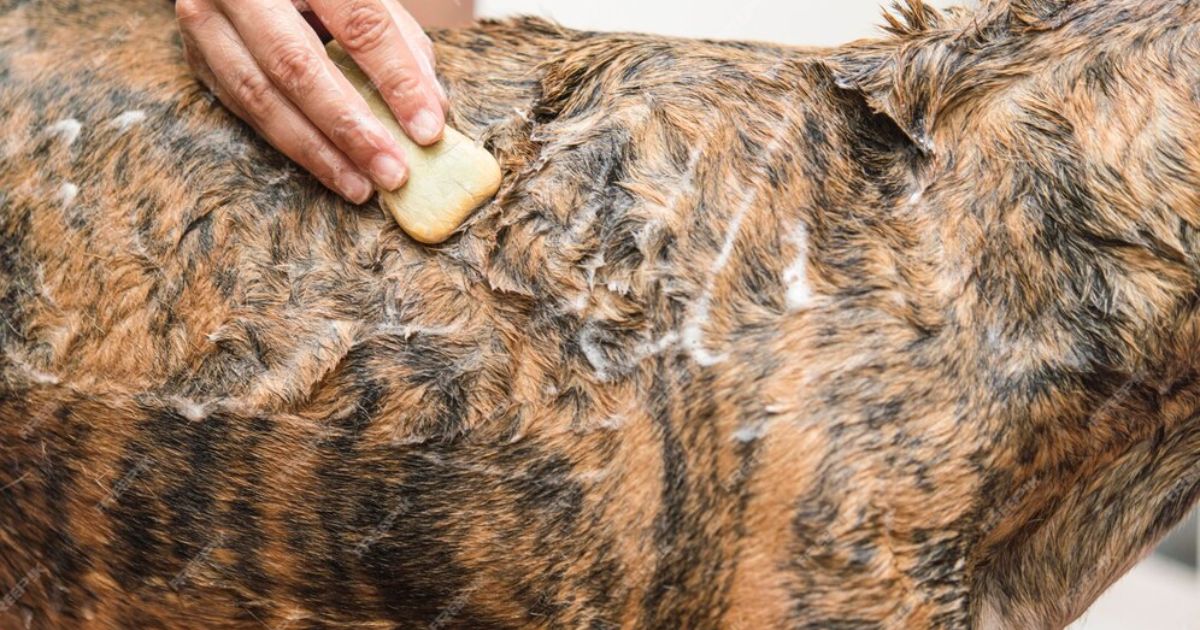It is generally not recommended to leave coconut oil on your dog overnight. While coconut oil does have some benefits for a dog’s skin and coat, leaving it on for extended periods can potentially clog their pores and cause irritation. Coconut oil should only be applied topically to spots in need and allowed to absorb before your dog engages in normal activities like playing, sleeping or bathing. For best results, apply coconut oil daily as needed but remove any excess oil that has not absorbed into the skin within 30 minutes. In this article, we delve into the question on many minds: Can I Leave Coconut Oil on My Dog Overnight?
How to Apply Coconut Oil on Your Dog
Coconut oil offers tremendous health and grooming benefits when applied externally to dog coats and skin or given orally. To allow the oil’s moisturizing, anti-bacterial and conditioning properties to fully work, learning proper application guidelines helps. Focus application on dry skin patches, irritated areas or skin folds prone to rashes.
Lightly massage oil into the fur and skin rather than heavily coating. Spread onto paws, nose and ears gently avoiding eyes. Start with small amounts to test sensitivity. Proper dosing for oral consumption depends on dog size. Always supervise your dog when first using coconut oil to monitor reaction. Introduce slowly transitioning from topical use to ingestion to allow adjustment.
Can I Apply Coconut Oil on My Dog’s Nose?

Coconut oil makes an excellent moisturizer for cracked, dry dog noses prone to irritation. The oil’s fatty acids condition the tender nasal planum skin while fighting bacterial or fungal overgrowth causing scaly sores. Its hydrating properties prevent painful cracking from winter cold, summer sun or indoor heat triggering rhinitis flareups. Plus the tropical scent appeals to canine senses of smells.
When applying to the nose, only use a very thin layer to avoid excess oil residue. Focus just on the nose leather itself not the nostrils, using a cotton ball. Check for redness or excessive face licking afterward. Discontinue if reactions occur. Most dogs tolerate virgin coconut oil well for gentle nose moisturizing benefits though spot testing any new topical is wise.
Is Coconut Oil Safe For Dogs’ Skin?
Daily topical usage benefits skin and coat health. The light texture also rinses out easier compared to thicker oils. Potential sensitivities to coconut itself or its fat content rarely occur but remain possible. Test small skin patches first when applying especially to smaller, elderly or allergy-prone dogs. But generally coconut oil earns its reputation as a premium, nourishing oil for dogs’ skin when integrated into grooming routines.
How Long Can You Leave Coconut Oil on a Dog?
When applying coconut oil topically to dogs’ coats and skin for hydrating essential fatty acids and beneficial antioxidants, absorption rate guides ideal leave-on duration. Light concentrations of coconut oil fully absorb within 8-12 hours max. Leaving oil beyond 12 hours risks residues transferring onto furnishings. For deeper penetration to benefit skin, several hours of contact works well.
But coating fur intended mostly as a conditioning rinse-out treatment needs only minimal leave-on time before bathing out. For reference, massaged skin absorbs coconut oil within 90 minutes while hair shafts require closer to 8 hours. So the ideal leave-on time frames between an overnight application providing moisturizing benefits and a quicker grooming regimen simply imparting coat shine.
Can You Put Coconut Oil on Dogs’ Paws?

Dog parents can safely apply coconut oil to moisturize cracked, raw paw pads or soothe abrasions between toe crevices. The oil’s concentrated medium-chain triglycerides offer natural antibacterial, antifungal benefits to protect against infection-causing germs. Caprylic acid converts into antiseptic monocaprin upon skin contact to fight external pathogens. Lauric acid’s hydrating properties prevent further pad cracking.
Plus the oil’s vitamin E content encourages tissue healing while still soothing irritation. These compounds treat sore paws without stinging like alcohol-based cleaners. Simply massage lightly onto clean paws avoiding fur. The oil absorbs fully overnight when applied before bedtime. Coconut oil works wonders nurturing tough paw skin vulnerable to weather, terrain and seasonal salt/chemical exposure.
Benefits of Coconut Oil for Dogs
May Be Used as Medicine
Ingesting or topically applying pharmaceutical-grade virgin coconut oil offers therapeutic advantages for dogs. Concentrations of antiviral, antibacterial and anti-inflammatory lauric acid benefit immune health. MCTs provide fast energy and ketones to sharpen mental function and control epilepsy seizures.
Lauric acid converts to monolaurin to battle parasites, viruses and infections without toxicity. Powerful antioxidants fight cartilage damage, arthritis and aging. Using coconut oil both internally and externally speeds healing of upset stomachs, skin conditions, ear infections, flea allergies and more. Always source reputable supplement-quality oil produced specifically for pets. Dose by weight using coconut oil both as targeted treatment and daily supplemental medicine.
May Make Drug Administration Easier and More Palatable
Mixing medications, supplements or essential oils into coconut oil before giving dogs oral doses helps easier delivery and administration. The oil binds to active ingredients and encapsulates them to ensure full ingestion. This prevents dogs from sensing and spitting out bitter powders or pungent emulsions they dislike. Coconut oil also shields teeth from staining from antibiotic syrups.
Its inherent palatability and flavor masks unpleasant tastes dogs typically avoid. The oil’s density allows blending powders and liquids into a pliable dough easily spoon-fed. As a binding agent and chaser, adding coconut oil helps dogs happily cooperate taking needed prescription and over the counter drugs without the usual struggle and stress of forced oral dosing.
May Be Used as a Food Supplement
Adding small coconut oil amounts to dogs’ diets supplies beneficial daily nutrition. Alongside its antiviral, anti-fungal and antibacterial richness, coconut oil provides energy-enhancing medium chain triglycerides, protein building-blocks in amino acids, and bone-protecting manganese and calcium. Antioxidants fight disease and slow cellular aging.
Supplementing food with ultra-absorbable caprylic acid, lauric acid, capric acid and vitamin E concentrates these advantages. Start with 1⁄4 teaspoon per 10 pounds body weight added to meals. Slowly increase up to 1 tablespoon for large dogs based on energy, stool and weight changes. More than a treat, regular coconut oil improves whole-body wellness. Monitor thyroid levels in supplementing for extended periods.
May Be Used as a Moisturizer
Rubbing coconut oil into dry, cracking paw pads, itchy skin folds and abrasions utilizes its unparalleled moisturizing effects for superior healing. The oil’s medium chain fatty acids deeply penetrate skin faster than other oils. Lauric acid, capric acid and other emollients penetrate the dermis to alleviate inflammation and irritation beneath the surface. This facilitates faster reparation and restoration for damaged tissue.
Dry skin and keratinized disorders respond beautifully to coconut oil’s hydration. Its healing benefits concentrate in topical usage directly targeting affected areas systemically through dog’s self-licking as well. Applying to localized sores prevents infection as powerful antibacterial properties get absorbed.
May Be Used for Wound Management
Wounds require protection against infection to heal properly. Diluted with lavender, tea tree or other carrier oils then applied around the perimeter of sutures, wounds and cuts, coconut oil forms a protective barrier shielding against bacteria and dirt. Caprylic acid coverts into an antiseptic layer keeping pathogens out despite licking or contact contamination. The oil also speeds local blood supply to improve tissue oxygenation and regeneration. Its vitamin E benefits scarring while fighting inflammation. Used with e-collars preventing licking, coconut oil nurtures wounds keeping the area supple to prevent cracking scabs and complications as skin knits back together. All while avoiding harsh chemicals that would sting.
May Be Used for Dental Management
Incorporating coconut into dental care routines combats plaque naturally with enzymes fighting bacteria-causing gingivitis, periodontal infections and cavities. Lauric acid concentrate into antiviral monolaurin to kill pathogens lingering in saliva contributing to tartar buildup and receding gums. Oil pulling draws out infection immersing teeth in natural antiseptic wash.
Coconut oil added to drinking water inhibits biofilm clinging to tooth surfaces to inhibit decay. Plus coconut’s taste appeals to dogs unlike minty pastes. Using coconut oil instead of antiseptic rinses soothes inflamed sore gums after cleanings without alcohol stinging. Over time plaque slows while breath freshens.
May Be Used as a Flea and Tick Deterrent
Flea and tick infestations irritate dog skin and transmit dangerous diseases. Used topically or fed as a supplement, coconut oil may deter biting insects through multiple modes of action. Lauric acid concentrate into insecticidal monolaurin toxin fatal to fleas and ticks but harmless to mammals. This insect toxicity reduces bites after exposure but doesn’t equal chemically formulated veterinary preventatives completely eradicating infestations.
Additionally components block insect odor detection of hosts. This dual approach firstly kills them on contact while secondly masking dog scent trails to some degree. Another benefit: compared to harsh chemical flea collars and topicals that commonly provoke allergic reactions, coconut oil causes less skin sensitivity. Using coconut oil as one part of non-toxic flea prevention can supplement other measures.
How to Apply Coconut Oil on Your Dog: 5 Easy Steps
Step 1: Prep the oil
Begin by selecting a high quality virgin or refined coconut oil intended for pet usage. Test a dime sized amount on your forearm for any reaction beforehand. Measure out the proper dosage for your dog’s size. Warm a small amount until liquid between palms for easier spreading if applying to skin or fur.
Step 2: Choose an application area
Determine whether targeting a specific area of concern like the nose, paws or hot spots for therapeutic effects or applying as part of wider grooming. Dogs benefit from both localized treatment of irritations and overall conditioning.
Step 3: Apply the oil lightly
Rub a thin uniform layer into the coat working down to the skin without over-saturating the hair or creating drips. Take care avoiding eyes, ears and mucus membranes. Focus on dry skin, cracked nose leather, chewed paws or flakey skin patches enabling the oil’s deep absorption.
Step 4: Brush the coat afterwards
Once applied to the area, let the oil soak in for several minutes before brushing through the fur to evenly distribute it wider without clumping. Use a wide-toothed comb to fully integrate oil across the coat to the skin for maximum conditioning and stimulation of hair follicles.
Step 5: Clean up excess oil
Carefully wipe any visible residue off furnishings and flooring to prevent grease stains long-term. Wash hands after application as well. Monitor your dog following initial topical use and first few days ingesting oil to watch for potential allergic reactions, which are very rare.
How to Remove Coconut Oil from Dog Fur

While coconut oil offers tremendous benefits for dogs’ skin and coats, excess oil left sitting in fur can transfer onto furniture and floors. Learning proper removal prevents messes. Start by brushing dry fur with a slicker brush to dislodge residues a day after application. Next bathe your dog using gentle dog shampoo to wash away remaining oil fully without irritation.
For smaller amounts, rubbing a bit of liquid soap, corn starch or milk powder into oily patches then brushing once dry also lifts oil effectively. Limit future applications to only how much your dog’s coat will absorb based on their hair length and density to prevent buildup. Properly removing excess oil residue keeps your dog and home tidy.
How to Rinse Off Coconut Oil from the Dog’s Body
After topically applying coconut oil across your dog’s body for healthy skin and lustrous fur, follow these tips for easy removal during bathing:
- First, brush the dry coat before bathing to loosen and remove any lingering flakes or clumps sitting on top. This prepares the hair shafts for shampooing.
- Next wet your dog’s coat thoroughly before lathering up shampoo, allowing the water to penetrate down to the skin.
- Massage shampoo gently over the oiled areas like the back, chest and legs to emulsify then dissolve the oil into the shampoo suds.
- Let the shampoo sit for 2-3 minutes to allow surfactants to fully lift residue away down the fur and off the skin before rinsing.
- Rinse thoroughly with warm water removing all traces of shampoo and residue until water runs clear.
- Follow up with an oil-free conditioning treatment if desired for continued coat nourishment after washing away excess oil.
- Proper water temperature, shampooing technique and rinsing lifts even concentrated coconut oil easily in bathing without irritating the skin if completed patiently. Pay special attention to oil-prone areas like the back and tail. Over time coconut oil ingestion and topical absorption normalizes minimizing buildup.
Related Post : Do I Have Separation Anxiety From My Dog Quiz?
FAQ’s
Is it safe to leave coconut oil on my dog overnight?
While coconut oil has many skincare benefits for dogs, it’s generally not recommended to leave it on their coat overnight since they may try to lick it off and it could get in their eyes.
Will coconut oil clog my dog’s fur?
No, coconut oil is non-comedogenic and won’t clog pores or coat like other oils. It absorbs easily without leaving residue.
Does coconut oil help with fleas?
Coconut oil can help repel fleas when massaged into coats. However, for best results, be sure to also use vet-approved flea treatment as fleas may still be present overnight posing risks.
Conclusion
Finally, while coconut oil has many benefits for dogs and their skin and coat, it is generally not recommended to leave it on overnight. Coconut oil is a safe and natural moisturizer that can relieve dry skin and improve the condition of the skin. When applied topically, its antibacterial properties can help with mild skin problems. However, there is a risk that the dog may try to lick the oil in its sleep and accidentally ingest it. Overdose can potentially cause diarrhea or stomach upset. For best results, it’s usually enough to apply coconut oil and massage it in while brushing in the evening, without leaving a thick coating overnight.









